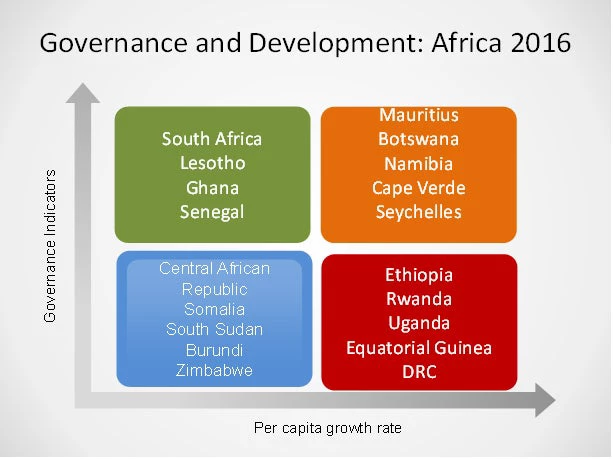For any serious analysis of development in Africa, we must embrace the fact that there are distinct sovereign countries each with its own economic and development needs and likely policy choices. Perhaps at best we can only generalize about clusters of countries that share broadly similar governance, legal and development circumstances and what policies could apply to each cluster.
Let’s look at some of the data. National populations in sub-Saharan Africa range from that of Nigeria (158.4 million) to that of Seychelles (93,000). In 2014, Africa’s highest estimated GNI per capita that of Equatorial Guinea ($10,210), was 27 times larger than that of the Democratic Republic of the Congo, the lowest recorded in the region. In 2013, the estimated GDP per capita of the ten richest African countries was 22.6 times that of the poorest ten. Adult literacy rates in 2013 ranged from 93 percent in Equatorial Guinea to 34 percent in Chad.
In its issue of May 13, 2000, The Economist magazine carried a banner headline calling Africa “The Hopeless Continent” because, it proceeded to argue, of its peoples’ predisposition to bloody civil wars, corruption, civil disorder and tyrannical rulers. It wondered if all these were traceable to an African “inherent character flaw”. In its issue of March 2nd 2013, the same magazine labeled Africa “The hopeful Continent” and proceeded, alongside Time Magazine and The Wall Street Journal to feature the theme of “Africa Rising” as East Asia had done decades earlier. Reforms in national governance, good macro-economic management and new technocratic leadership were the reasons advanced to explain the swift transition from the extreme of hopelessness to the one of a rising Africa.
Uneven development?
As far back as 1958, Albert Hirschman had in The Strategy of Economic Development argued that instead of pursuing the idyll of a “big push” in balanced growth across sectors, and given the conceptual problems of anticipating in advance the setbacks and benefits that would result in such a wide span of major investments, it made more sense to pursue an unbalanced development strategy, where intervention in one sector (like infrastructure) would stimulate cognate productive private investment and vice versa, in a continuing oscillating sequence. Each move would provide market-based incentives for “forward and backward linkages”. This general perspective was repeated in the 2009 World Development Report.
The notion could be applied to sequential transition from economic transformation to law-based governance and vice versa, between sectors, and between countries in an economic integration region. All this is premised on the belief that to declare a national development or governance reform initiative as hopeless—as has happened so often in Africa—it is necessary to overestimate handicaps and underestimate gains.
In Why Economists Got it Wrong, (Zed Books 2015), Morten Jerven argues with ample data, contrary to the argument that the record of Africa’s economic growth has been dismal over the previous six decades, there had been episodes of remarkable economic expansion with rising social indicators in health and education. But growth tends to be cyclical, like everywhere else. Earlier on, Dani Rodrik had detected significant African growth episodes in the years preceding the lost 1980s and 90s decades.
But there was always a number of development and governance scholars of Africa who dissented from the gloom and doom scenario. One of the most remarkable examples is Steven Radelet whose book Emerging Africa: How Seventeen Countries are Leading the Way (Centre for Global Development, 2010), points out the remarkable progress in economic and social indicators in countries from Botswana and Burkina Faso to Uganda and Zambia. Radelet attributes success to more democracy and accountable governance, sensible economic policies, and debt renegotiation, among other reasons. Radelet’s publication came out in the same year as the World Bank’s volume Yes, Africa Can: Success Stories from a Dynamic Continent, edited by Punam Chuhan-Pole and Manka Angwafo, which contained a good number of successful growth experiences combined with governance and institutional reforms that could stimulate contagion in lagging African states through a number of channels.
Still, the situation is mixed. And is mixed even within countries: in Nigeria for instance the state HDI ranges from 0.63 in Akwa Ibom to 0.29 in Yobe. We cannot ignore a number of African countries (and regions in countries) still handicapped by violent political instability, economic regress and famine in the manner portrayed by the iconic “Hopeless Continent” headlines of the 1990s. The challenge is to ensure that the net again in the number of African states with law-based governance in one phase is higher than in the previous one, since some countries in the hopeful category could drop off.
Where do we go from here?
For simplicity, in the upcoming World Development Report 2017, we have categorized a selected number of African countries in a four-cell matrix above with a vertical governance axis and a horizontal economic growth axis. This is a work in progress. But it is a useful indicator of the thought process required in making the intellectual transition from the cross generalizations on Africa, to one characterized not only by diversity but with real possibilities of countries moving to the ideal higher levels of law-based governance with shared prosperity in sequence and through multiple paths. Our goal should be to expand the numbers in the top right quadrant in iterative sequences, coming from several directions.


Join the Conversation